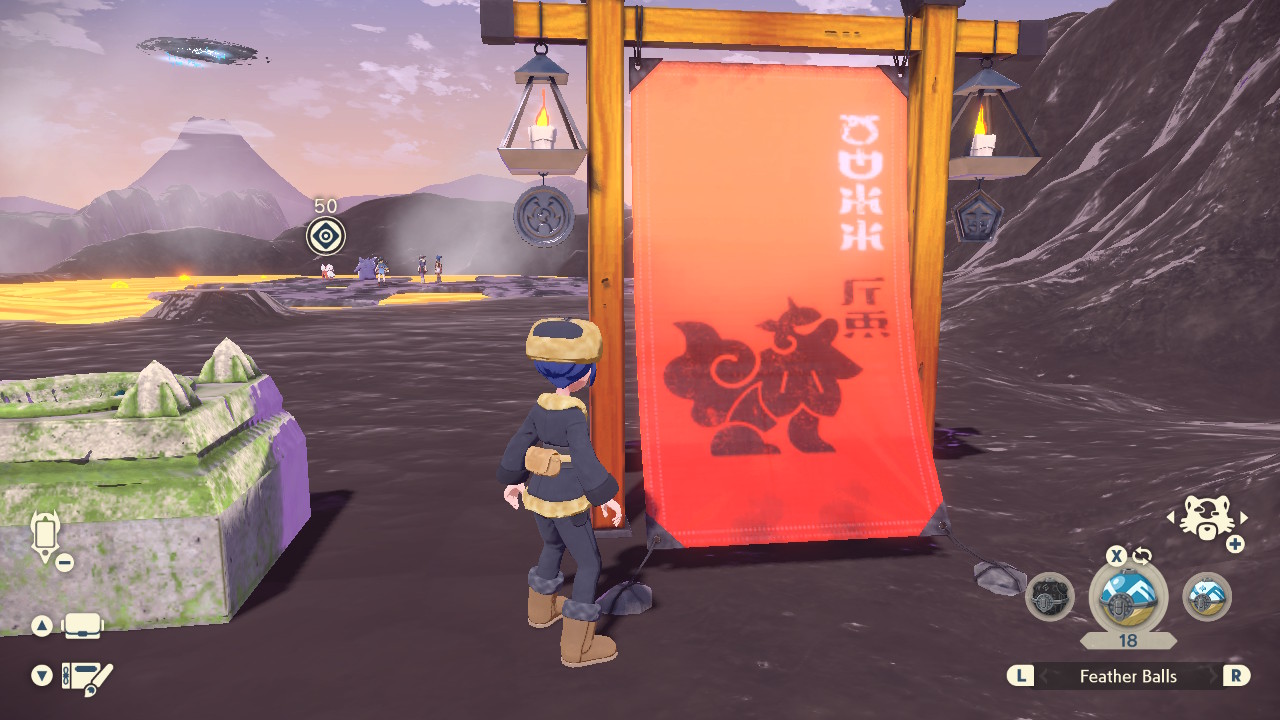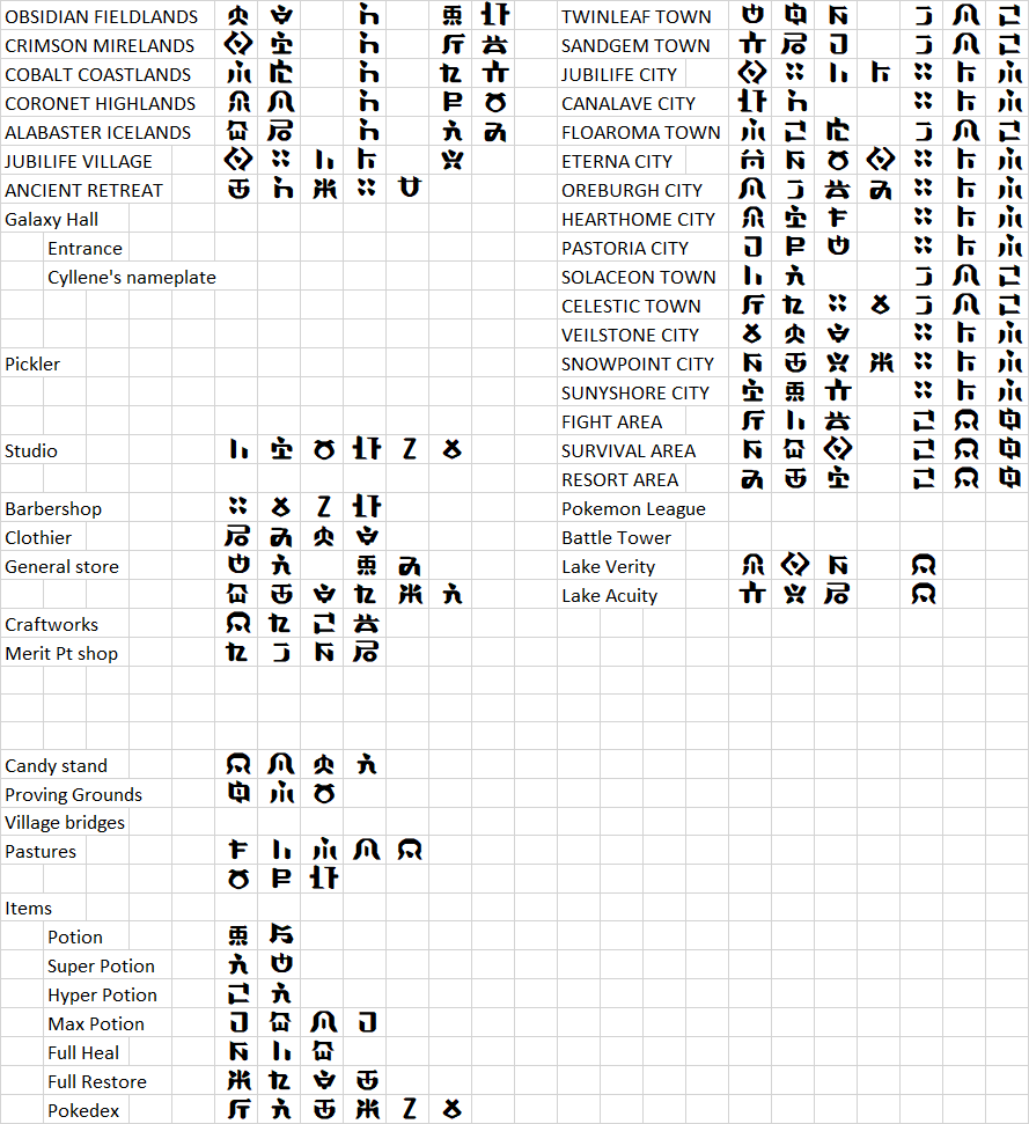
Since the olden days of the Sinnoh Region, when it used to be known as the Hisui Region, the people there used a certain language on all of their signs: which we’ve dubbed “Hisuian”. This language has been vividly depicted in both Pokémon Legends: Arceus and Pokémon BrillianDiamond/ShiningPearl, but has been largely undeciphered… until now! In fact, if you’re familiar with the research we’ve done on PokéLatin (Galarian/Paldean language)—which turned out to be little more than “consistent gibberish”—then you may be pleasantly surprised to discover that Hisuian is actually a fleshed out, coherent language based on Japanese!
When the first videos about BDSP and PLA were released, research on Hisuian/Sinnohese started immediately when consistant lettering was found throughout:


Once the games were released, it became clear that the two were designed to share the same language script, unifying the two games.
This page will cover all available research on the Hisuian language, with nearly all of the work and credit going to elementsnstuff from the The Language Institute channel over at the PA! Discord. But there’s still plenty of room for more research to unlock even more secrets, as there are still a lot MORE left to be uncovered and discovered. That said, here’s what we’ve been able to sort out so far:
Let’s get the basics out of the way:
- As mentioned, Hisuian is a fleshed out, coherent language and script, unlike the consistent gibberish of PokéLatin.
- Hisuian is based on Japanese, and is therefore a syllabic script, which each character generally representing a consonent/vowel pair.
- Unlike Japanese, however, there is only one script (Hisuian), whereas Japanese has three (the syllabic hiragana and katakana, and the Chinese-characters based kanji)
- Hisuian has 43 known characters, as seen in the chart below.
- Also unlike Japanese, Hisuian doesn’t use dakuten and handakuten diacritics to create new sounds. For example with Katakana, キ ki plus the ゛ dakuten diacritic creates the character ギ gi… however, Hisuian gi and ki characters are unique and don’t resemble one another.
- Therefore, theoretically Hisuian could have up to 76 unique characters, but the other 33 have not been found. And without another game that uses Hisuian, those remaining 33 may never been found.
- There is also some weirdness where yō-on (ゃ/ャ, ゅ/ュ, ょ/ョ) and sokuon (っ/ッ)—basically the tiny extra characters used to change the sound of the preceeding character—are actually full sized.
- For example, like ポッキー would be written as ポツキー, or シャマン would be written like シヤマン, thus making translation a bit hard… is it supposed to be ポッキー Pokki or ポツキー Potsuki, or is it シャマン syaman or シヤマン shiyamon? This is where some of the raw Hisuian words need to be finessed in order to get the true translation.
- Many words can be translated—which is how we know what we know about Hisuian—but many still have to be translated. That is to say, we know that a Hisuian phrase says (for example) donigema, but we don’t know if it’s either:
- donigema
- do nigema
- doni gema
- donige ma
- doni ge ma
- do ni gema
- do ni ge ma
- This is because Japanese uses different kanji characters for more than just one syllable, so perhaps “do nigema” might be spelled completely different (and thus have a different meaning) to “donige ma”.
- Of course, it IS possible that THESE untranslated words are complete gibberish, similar to the common junk words seen in PokéLatin.
Character Guide
The 43 characters of Hisuian that were found are below:

So knowing the Hisuian script, it means that this sign for example says: Yuhasusu Mume.

That could mean “湯はすす むめ” or “the water is soothing” (according to Google Translate). Is that a joke about the lava, or maybe there’s hot springs? Or maybe it’s just “湯はすす”, which Google Translate says it means “the water is soot”, and むめ is just the Hisuian name for Arcanine? My Japanese is awful so I’ll conceed to any other interpretation of this. But regardless, Yuhasusu Mume is what the Hisuian text says.
…
Finally, here is a quick guide of words which have been cataloged and deciphered.

There’s a LOT MORE to come, but I just wanted to get this information up so you can see it. Keep an eye out for further updates, including how elementsnstuff managed to work this all out to begin with, and how we know it’s NOT gibberish and the letters ARE consistant.
